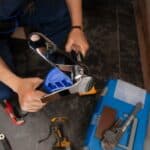
Eyelid ptosis is when the upper eyelid starts to droop, making it harder to keep your eyes fully open. As we age, this muscle, called the levator, can weaken and stretch, leading to sagging eyelids. Now, you might be thinking about how to fix droopy eyelids. Ptosis surgery is the solution! It is a procedure that tightens the muscle responsible for lifting the upper eyelid.You can also do eyelid exercises at home to reduce it.
Before opting for eyelid ptosis surgery, here are 5 things to know before getting eyelid ptosis surgery.
1. What are the Benefits of Ptosis Surgery?
Ptosis surgery, also known as drooping upper eyelid surgery, offers several advantages, including:
- Vision Improvement: Raising the eyelid helps to improve vision from that eye.
- Preventing Vision Development Issues in Children: In young children, correcting ptosis that covers the pupil can prevent permanent vision development limitations (amblyopia). Lifting the eyelid enhances the stimulation of the eye and helps with vision development.
- Improved Aesthetics and Symmetry: Ptosis surgery helps to enhance the aesthetic appearance by creating more symmetrical eyelids.
- Eliminate the Eyebrow and Chin Strain: Ptosis surgery reduces the need to lift the eyebrows or chin, thereby alleviating associated tiredness or discomfort.
- Relief in Eye Strain: Ptosis surgery helps lift drooping eyelids and reduces the effort required to keep your eyes open, which can significantly relieve strain and improve overall comfort.
- Restoring a Balanced Look: By correcting droopy eyelids, ptosis surgery restores balance and symmetry to your eyes, creating a more refreshed and youthful appearance that enhances your natural facial features.
2. When Should I Consider Getting Ptosis Surgery?
As we age, our eyelids naturally begin to droop and sag. This process happens gradually, often taking years to become noticeable. You may not even realise the subtle changes until one day, you look in the mirror and see that your eyelids have started to droop more than before. In some cases, people only recognise the impact on their vision after they’ve had an eyelid lift.
Several factors can make your eyelids look even more tired or saggy, such as stress, lack of sleep, dehydration, or even recovering from an illness or a night out. These issues can worsen the signs of ageing, causing your eyes to appear more fatigued.
Beyond the aesthetic concerns, drooping eyelids can also affect the function of your eyes. This can lead to problems with blinking, tear production, or fully closing your eyelids. In more severe cases, your eyelashes may become hidden by your sagging eyelids or even start scratching your eyes.
If you feel that your eyelids are making you look tired or older than you are, or if you’re experiencing functional issues like trouble blinking or excessive tearing, it may be a good time to consider ptosis surgery. This procedure can help restore your eyes’ youthful appearance while addressing any functional problems.
3. What are the Risks and Complications Associated with Ptosis Surgery?
Despite being generally safe, there are potential risks and complications associated with the procedure, such as:
- Under- or over-correction: Sometimes, the eyelid may not be lifted enough or might be lifted too much, which could require another surgery to fix.
- Asymmetry: After surgery, one eye might look slightly different from the other, which is pretty common.
- Scarring: A small scar can form where the skin is cut.
- Infection: Observe for signs like swelling, redness, discharge, or more pain than usual, as these could mean an infection.
- Bleeding: There may be some bleeding in the surgery area, or a small lump could form near the wound.
- Temporary difficulty closing the eye: If the eyelid is lifted too much, it might be hard to fully close the eye for a while.
- Corneal ulcer: If a stitch is left in too long, it might lead to a corneal ulcer.
- Loss of vision: In rare cases, blood can collect behind the eye and press on the optic nerve, which could cause vision loss.
After surgery, you may have bruising, swelling, and discomfort for a few days. You may also experience blurred vision for a few days.
4. How Much Time Does Recovery Take After Ptosis Surgery?
The recovery time for eyelid surgery, also known as blepharoplasty, typically lasts a few weeks but can vary depending on individual healing and the extent of the procedure.
Right after the surgery, your eyelids may feel tight and uncomfortable, and you may notice some bruising and swelling. This usually peaks around the second day after the surgery. You may also experience blurry vision due to the ointment applied to your eyes during surgery or from tearing or swelling.
During the first week or two, most of the swelling and bruising should begin to decrease. To help with this, your doctor will likely suggest using cold compresses and keeping your head elevated as much as possible. Over-the-counter pain relievers can be used to manage any discomfort, and your surgeon may also prescribe pain medication.
Stitches are normally removed within a week of surgery. After this, you should start feeling more comfortable and be able to return to your daily activities, although strenuous physical activity should be avoided for at least a few weeks.
5. How Can I Prepare for the Surgery?
If the surgery is done with a local anaesthetic, it’s important to remain still and lie flat during the procedure. If you are unable to do so, inform your surgeon.
If you smoke, quitting now can lower your chances of experiencing complications and improve your overall health in the long term.
Maintaining a healthy weight is important, as being overweight increases the risk of complications.
Maintaining a healthy weight is important because being overweight increases the risk of complications. Regular physical activity can help you prepare for surgery, aid in your recovery, and improve your long-term health. Before starting any exercise routine, seek advice from the healthcare team or your GP.
Conclusion
Ptosis surgery can significantly improve your eyelids’ appearance and function, but it’s essential to approach it with care and understanding. When considering ptosis eye surgery in Leeds, make sure to research thoroughly and choose a qualified surgeon who specialises in this delicate procedure. Your face is your most recognisable feature, and if anything goes wrong, it’s not easy to conceal.

Rent Thai Clothes Embracing Thai Tradition with Elegance

The Ultimate Guide to CCTV Installation Services

Creative Ways to Utilize Business Signage Beyond Branding

Pre-Requisites Before Applying for an Instant Personal Loan

Embrace the Magic of Turkey: An Unforgettable Visit

Tear Trough Fillers: All Common Questions Answered

5 Things to Know Before Getting Eyelid Ptosis Surgery

Pelvic Floor Health and Its Impact on Mental Well-being








